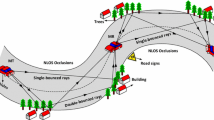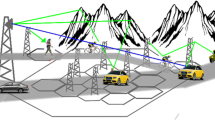Abstract
The intelligent transportation systems have attracted the attention of many researchers and developers in the last few decades in order to make the exploitation of transportation networks be safer, more coordinated, and smarter. Channel modeling for vehicle-to-vehicle (V2V) communication is one of the related research topics that are being investigated in this field. In this paper, a three-dimensional wideband regular shaped geometry based channel model for multiple-input and multiple-output V2V communication channel is proposed for rectangular tunnel environments. A two semi-circular geometry is adopted to describe moving vehicles around transmitter and receiver, and a cuboid model is employed to depict scatterers located on internal surfaces of the tunnel walls. Using this channel model, the channel characteristics including space time correlation function, frequency correlation function and auto-correlation function are determined and simulated numerically. Then, the results are compared with the derived statistics from Avazov et al. and Zhou et al. methods to prove the efficiency of the proposed model.
Access this chapter
Tax calculation will be finalised at checkout
Purchases are for personal use only
Similar content being viewed by others
References
Zadobrischi, E., Dimian, M.: Vehicular communications utility in road safety applications: a step toward self-aware intelligent traffic systems. Symmetry 13(3), 438 (2021)
Arena, F., Giovanni, P.: An overview of vehicular communications. Future Internet 11(2), 27 (2019)
Matolak, D.W.: Modeling the vehicle-to-vehicle propagation channel: a review. Radio Sci. 49(9), 721–736 (2014)
El Zorkany, M., et al.: Vehicle to vehicle communication: scope, importance, challenges, research directions and future. Open Transp. J. 14(4), 86–98 (2020)
Chebil, J., Zormati, H., Taher, J.B.H.: Geometry based channel modeling for V2V communication: a review. Int. J. Antennas Propag. 2021, 1–10 (2021)
Karedal, J., et al.: A geometry-based stochastic MIMO model for vehicle-to-vehicle communications. IEEE Trans. Wirel. Commun. 8(7), 3646–3657 (2009)
Dreyer, N., et al.: A comparison of stochastic and deterministic channel models for V2V applications. In: Proceedings of the 2020 EuCNC, Dubrovnik, Croatia, pp. 79–83 (2020)
Yin, X., Cheng, X.: Propagation Channel Characterization, Parameter Estimation, and Modeling for Wireless Communications. Wiley, Singapore (2016)
Jiang, H., Zhang, Z., Gui, G.: A novel estimated wideband geometry-based vehicle-to-vehicle channel model using an AoD and AoA estimation algorithm. IEEE Access 7, 35124–35131 (2019)
Wu, S., Wang, C.-X., Aggoune, e.-H.M, Alwakeel, M.M., You, X.: A general 3-D non-stationary 5G wireless channel model. IEEE Trans. Commun. 66(7), 3065–3078 (2018)
Avazov, N., Islam, S.M.R., Park, D., Kwak, K.S.: Statistical characterization of a 3-D propagation model for V2V channels in rectangular tunnels. IEEE Antennas Wirel. Propag. Lett. 16, 2392–2395 (2017)
Zhou, J., Chen, Z., Jiang, H., Kikuchi, H.: Channel modelling for vehicle-to-vehicle MIMO communications in geometrical rectangular tunnel scenarios. IET Commun. 14(19), 3420–3427 (2020)
Jiang, H., Chen, Z., Zhou, J., Dang, J., Wu, L.: A general 3D non-stationary wideband twin-cluster channel model for 5G V2V tunnel communication environments. IEEE Access 7, 137744–137751 (2019)
Author information
Authors and Affiliations
Corresponding author
Editor information
Editors and Affiliations
Rights and permissions
Copyright information
© 2022 The Author(s), under exclusive license to Springer Nature Switzerland AG
About this paper
Cite this paper
Chebil, J., Zormati, H., Mansour, A., Ben Mabrouk, I., Bel Hadj Tahar, J. (2022). A New 3D-Regular Shaped Geometry-Based MIMO Channel Model for Vehicle-to-Vehicle Communications in Rectangular Tunnel. In: Nguyen, N.T., Manolopoulos, Y., Chbeir, R., Kozierkiewicz, A., Trawiński, B. (eds) Computational Collective Intelligence. ICCCI 2022. Lecture Notes in Computer Science(), vol 13501. Springer, Cham. https://doi.org/10.1007/978-3-031-16014-1_63
Download citation
DOI: https://doi.org/10.1007/978-3-031-16014-1_63
Published:
Publisher Name: Springer, Cham
Print ISBN: 978-3-031-16013-4
Online ISBN: 978-3-031-16014-1
eBook Packages: Computer ScienceComputer Science (R0)




